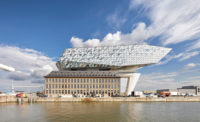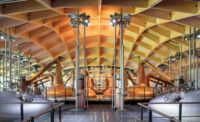Manchester, England
The Whitworth Gallery, in England’s booming second city, Manchester, is a cultural institution that took a walk in the park back in 1889—it was the first English art museum to adopt a parkland rather than urban setting—and now has taken another. The story is a familiar one: venerable creaking-at-the-seams regional establishment receives total makeover and expansion to accommodate a growing collection and audience. But it is rarely done so convincingly as this. Its ingenious addition embraces the landscape and transforms the old building, in what is the breakout project for its architects, MUMA.
The firm founders—Gillian McInnes, Simon Usher, and Stuart McKnight—were relatively unknown when they won the competition for this $22 million project back in 2009. The trio first met at the Glasgow School of Art and had worked for Michael Wilford, surviving partner of James Stirling, before forming MUMA in 2000. By 2009, the firm’s most noteworthy accomplishment was a beautifully realized reworking of the Medieval and Renaissance galleries at London’s Victoria and Albert Museum. The Whitworth, however, is its first project with a substantial new public face.
MUMA’s big move was to interweave building with landscape at the rear. Originally, the Whitworth—created to inspire the region’s textile industry and housed in a typically grand, if relatively small, Victorian/Edwardian civic building in red brick and terra-cotta, designed by J.W. Beaumont—was in the 20-acre Whitworth Park but not of it, remaining resolutely blank-walled but for its set-back street frontage. A good mid-1960s rearrangement by architect John Bickerdike began to put that right. He inserted big windows in the previously blind arcade on the south side, providing views across the park. The new architects noticed how visitors tended to move toward the view and resolved to integrate the building more fully with its setting. As McKnight puts it, “The extension not only connects with the park, creating an outdoor gallery—the Art Garden—it also acts as a pressure relief, allowing us to reconfigure and rationalize the existing building.”
The original structure terminated with the blank brick ends of three barrel-roofed galleries, set above a semi-basement. MUMA has spliced a 21,200-square-foot, H-shaped extension onto this, providing circulation space to either side and via a broad glass-walled ambulatory across the ends of this new series of galleries. This is protected from the southwesterly sun by a filigree brise-soleil made of slender vertical strips of stainless steel. A pair of two-story wings extends westward: one, on a side street, contains a large red-brick-clad gallery, used often for display of the museum’s collection of landscape drawings and paintings, with a library and study center beneath, while the other is a delicate, Miesian rectangular box of a restaurant, high enough to feel as if it is in the canopy of the park’s trees. It cantilevers beyond the end of the level beneath (an education center) and has an upward-folding glass end wall, allowing it to open up to the outdoors in summer.
The ambulatory and restaurant are rendered ethereal by triangular flanking columns in highly polished stainless steel. The new brick elements, meanwhile, are textured, even “stitched,” with white ceramic insertions in a nod to the museum’s textile collections. The final move was to lower the semi-basement to give a proper story height to this new parkside entrance to the museum, behind which is the new Collection Centre on the same level. As with much that MUMA designed, says the museum’s director, Dr. Maria Balshaw, this was not in her original list of asks. “Did it exceed the brief?
Yes, it did, in unexpected ways. It’s really changing the way we operate,” she says. “We didn’t think how amazing it would be, for instance, to have everything in the collection on one level. The Collection Centre area—a bonus spot—has become one of the most popular parts of the building.” Its creation also resulted in an important shift in the original building; the high daylit volume of the Grand Hall, where collection storage had been moved in the 1970s, has now been recovered as a place for lectures and events. Prior to this reworking of the Whitworth, all visitors came and went via the original entrance, which was often congested with deliveries, school groups, and a busy café. Now, says Balshaw, museumgoers use the back entrance almost as much as the front, especially in summer months—understandably, given the Art Garden between the two new rear wings, landscaped by Sarah Price. This is edged with benches, carved from Purbeck limestone, integrated with the architecture between building columns.
Inside the lower ambulatory, the benches are duplicated in oak. “It’s a convivial place,” says Balshaw. Buried deep beneath it is a phalanx of “earth tubes” cooling the inlet air to the building so that air-conditioning is not needed. This and ground-source heat pumps are key to the reworked building’s gaining a BREEAM< “Excellent” from the UK’s BRE Environmental Assessment Method, a rating considered more difficult to achieve than LEED Gold. By eliminating high-energy-consumption mechanical- cooling and humidity-control devices, overall carbon emissions are reduced by 10 percent even though the building is now almost a third larger, with doubled public areas and visitor numbers.
The new museum is effectively two interconnected buildings back-to-back. Although the older portion has been lightly refurbished and is now served by elevators to all levels, inevitably it is the addition that provides the main draw. Once forbidding, the Whitworth has become informal and approachable. And as befits the museum’s collecting tradition, it is a work of craft as much as architecture.














Post a comment to this article
Report Abusive Comment